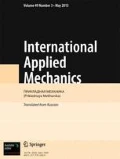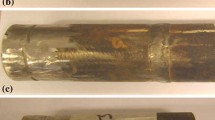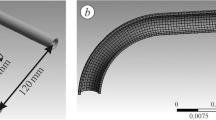During the operation of a steam generator (SG), the heat-exchange tubes (HET) and SG surface are sludged because of the inappropriate chemical and thermal conditions. The sludge accumulation can cause different defects, such as wall thickness reduction, cracks, pitting, etc. In combination with the effect of the sludge weight on the tubes and restraints for the design movement of tubes, defects change the stress–strain state of the HET substantially. To reliably evaluate the stress–strain state of the HET where sludge is accumulated and there are defects, appropriate studies were performed. The results of studying the effect of cracks on the stress–strain state and integrity of the HET are presented.
Similar content being viewed by others
References
G. V. Arkadov, A. F. Getman, and A. N. Rodionov, Reliability of Equipment and Pipelines of NPP and Optimization of Their Life Cycle (Probabilistic Methods) [in Russian], Energoatomizdat, Moscow (2010).
V. I. Astaf’ev, Yu. N. Radaev, and L. V. Stepanova, Nonlinear Fracture Mechanics [in Russian], Samarsk. Univ., Samara (2001).
M. B. Bakirov, M. S. Kleshchuk, S. V. Chubarov, et al., “Development of the atlas of defects in heat-exchanging tubes of steam generators of NPP with VVER,” in: Proc. 7th Int. Seminar on Horizontal Steam Generators (Podolsk, October 3–5, 2006), FGPU OKB Gidropress, Podolsk.
Energy Strategy of Ukraine for the Period up to 2035 “Safety, Energy Efficiency, Competitive Ability,” Ordinance No. 605-r of the Cabinet of Ministers from August 18, 2017.
Integrated Program of Works to Extend the Life of Operating Units of Nuclear Power Plants, Ordinance No. 263-r of the Cabinet of Ministers from April 29 (2004).
B. I. Lukasevich, N. B. Trunov, Yu. G. Dragunov, and S. E. Davidenko, Steam Generators of VVER Reactors of Nuclear Power Plants [in Russian], IKTs Akademkniga, Moscow (2004).
V. A. Mamet and O. I. Martynova, “Hide-out (local concentration) processes of impurities in boiler water of steam generators of NPPs and their effect on the reliability of equipment,” Teploenergetika, No. 7, 2–7 (1993).
Yu. G. Matviyenko, Models and Criteria of Fracture Mechanics [in Russian], Fizmatlit, Moscow (2006).
MT-T.0.03.224.11. Technique for Determining the Permissible Thickness of NPP Carbon Steel Pipeline Elements Subject to Errosion–Corrosive Wear [in Russian].
I. M. Neklyudov, L. S. Ozhigov, A. S. Mitrofanov, et al., “Corrosion damage of heat-exchanging tubes of steam generators at the Southern Ukrainian Nuclear Power Plant,” in: Proc. 7th Int. Seminar on Horizontal Steam Generators (Podolsk, October 3–5, 2006), FGPU OKB Gidropress, Podolsk.
Standards on Strength Analysis of Equipment and Pipelines of Nuclear Power Installations, PNAE G-7-002-86, Energoatomizdat, Moscow (1989).
2004 Status Report on PGV-440 and PGV-1000 Steam Generators of Power Units of Ukrainian NPPs, NAEK Energoatom, Kyiv (2015).
V. S. Popadchuk, N. B. Trunov, S. I. Brykov, et al., “Justification of the recommendations on providing the design life of heat-exchanging tubes of PGV-1000MKP steam generator,” in: Proc. 8th Int. Seminar on Horizontal Steam Generators (Podolsk, May 19–21, 2010), FGPU OKB Gidropress, Podolsk.
I. V. Orynyak, Strength Design of Pipelines with Defects, Vol. 4 of the five-volume series V. T. Troshchenko (ed.), Strength of Materials and Structures [in Russian], Inst. Probl. Prochn. im G. S. Pisarenko, Kyiv (2011).
ANSYS 16 Software, authorized for use by NNEGC Energoatom (enacted by Energoatom’s order No. 137-r from 2/5/2018).
Yu. V. Kharitonov, S. I. Brykov, and N. B. Trunov, “Predicting the deposition of corrosion products on heat-exchange surfaces of PGV-1000M steam generator,” Teploenergetika, No. 8, 20–22 (2001).
G. P. Cherepanov, Mechanics of Brittle Fracture, McGraw-Hill, New York (1979).
A. P. Shugailo, M. A. Mustafin, A-r P. Shugailo, et al., “Main results of evaluating the integrity of heat-exchange tubes of the steam generator of power unit No. 3 of Rivne NPP during emergency management,” Yadern. Radiats. Bezpeka, No. 3, 18–24 (2017).
R. A. Ainsworth, “The assessment of defects in structures of strain hardening material,” Eng. Fract. Mech., 19, 633–642 (1984).
E. Q. Andrade and A. C. Benjamin, “Structural evaluation of corrosion defects in pipelines: Comparison of FE analyses and assessment methods,” in: 14th Int. Offshore and Polar Engineering Conf., ISOPE 2004, May (2004), pp. 120–127.
M. E. Babeshko and V. G. Savchenko, “Elastoplastic axisymmetric deformation of shells under thermomechanical loading and radiation,” Int. Appl. Mech., 55, No. 6, 620–628 (2019).
P.A. Carlson and W. K. N. Kratzer, “Reactor steam generator performance,” Nuclear Technology, 28, No. 3, 383–387 (1976).
P. Z. Lugovoi, A. P. Shugailo, Ya. D. Krugliei, and A. M. Kolupaev, “Effect of sludge on the stress–strain state of heat-exchange tubes of a steam generator,” Int. Appl. Mech., 55, No. 1, 86–94 (2019).
P. Z. Lugovoi, Yu. V. Skosarenko, S. P. Orlenko, and A. P. Shugailo, “Application of the spline-collocation method to solve problems of statics and dynamics for multilayer cylindrical shells with design and manufacturing features,” Int. Appl. Mech., 55, No. 5, 524–533 (2019).
I. V. Orynyak, A. Ya. Krasovskiy, V. M. Borodiy, and S. M. Ageev, “Development of procedure for determination of wall thickness in NPP pipeline at erosion–corrosion wear of material,” Technical Diagnostics and Non-Destructive Testing, No. 4, 14–24 (2017).
V. G. Savchenko and M. E. Babeshko, “Technique of allowing for plastic strains under unloading in thermoplasticity problems for axysymmetric bodies,” Int. Appl. Mech., 55, No. 4, 416–425 (2019).
K. Splichal, M. Mikus, and I. Petrecky, “Effect of water chemistry on WWER steam generator corrosion damage,” in: Proc. IAEA, Specialists meeting, Ostrava, Chech Republic (1996), pp. 268–283.
R. J. Kurtz, R. A. Clark, E. R. Bradley, et al., Steam Generator Tube Integrity Program/Steam Generator Group Project: Final Project Summary Report (NUREG/CR-5117), Pacific Northwest Labora-tory Richland, WA99352, May (1990).
O. S. Tatone and R. S. Pathania, “Learning lesson of steam generators operating experience,” Nuclear Engineering Int., September, 29–33 (1983).
Author information
Authors and Affiliations
Corresponding author
Additional information
Translated from Prikladnaya Mekhanika, Vol. 57, No. 2, pp. 70–83, March–April 2021.
* This study was sponsored by the budgetary program Support of Priority Areas of Research (KPKVK 6541230).
Rights and permissions
About this article
Cite this article
Lugovyi, P.Z., Shugailo, O.P., Kruglii, Y.D. et al. Effect of Defects on the Stress–Strain State of Heat-Exchange Tubes of Steam Generators*. Int Appl Mech 57, 184–195 (2021). https://doi.org/10.1007/s10778-021-01072-8
Received:
Published:
Issue Date:
DOI: https://doi.org/10.1007/s10778-021-01072-8




